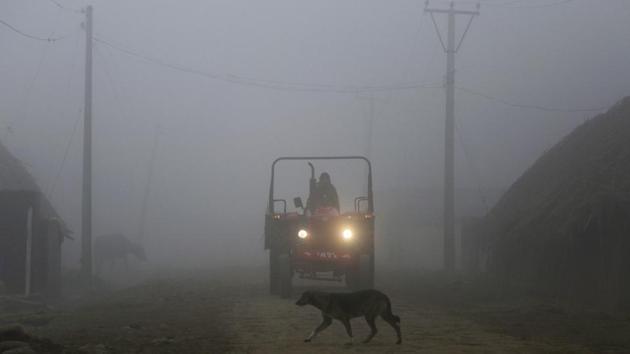Climate crisis hits insurance plan for crops
Delayed payouts have dogged the Pradhan Mantri Fasal Bima Yojana (PMFBY), the country’s flagship farm insurance scheme, since its roll-out in the summer of 2016.
Narayan Amre, a soyabean grower in Maharashtra’s Palghar, knew he was ruined when devastating rains in August washed away the entire crop on his four-hectare farm. “It’s a 100% loss,” he says.

Some of Amre’s losses will be covered by crop insurance, but it’s unclear when compensation will be paid and how much losses, in value terms, will be accepted by the insurance surveyors, he adds.
Delayed payouts have dogged the Pradhan Mantri Fasal Bima Yojana (PMFBY), the country’s flagship farm insurance scheme, since its roll-out in the summer of 2016. Now, there’s a new risk to be hedged, insurance companies say — climate crisis-induced extreme weather events.
Untimely rains and sudden drought have upended the farm insurance business, as loss-making insurers brace for an avalanche of claims this year from 12 states that witnessed widespread summer flooding. Maharashtra is by far the worst hit, data show.
The Maharashtra government has sought, through a memorandum to the Centre, a compensation of ~412.74 crore for losses to small and marginal farmers alone, who hold 48.2% of the state’s arable area.
“This year is going to be one of the most challenging. Unseen weather events, such as untimely rains, are complicating efforts to streamline PMFBY. We need better technology,” a government official said on condition of anonymity.
Neither insurance companies nor farmers are happy. Contrary to an impression that insurance firms are making money while farmers are running around for payments, this person added that the insurance industry, already facing losses, could be staring at its biggest ever payouts in agriculture this year.
“In Maharashtra alone, we have received 5.2 million intimations of 100% loss in soybean,” the official cited above said. Intimations refer to formal reporting by farmers of crop losses. Loss-ridden insurers are bracing for large claims also because the government in October 2018 enlarged the basket of risks to include untimely rains and post-harvest losses.
The state’s rainfall patterns were unusual and unprecedented, “none of which could be factored in, while assessing risks”, according to the official. Rainfall began a month late. Then, the districts of Dhule, Palghar, Thane, Nandurbar, Pune, Satara and Sanagli got 120% excess rainfall by August for the first time in 70 years, according to the India Meteorological Department (IMD). The state’s 11 major dams overflowed, leaving 16 districts flooded.
“There has been, no doubt, an increase in extreme weather and also the variability. Short spells of heavy rains are increasing and that of moderate rains are decreasing,” said Ajit Tyagi, a former chief of IMD.
The PMFBY faces a double whammy. While on the one hand farmers complain about payment delays, on the other, insurance companies say their claims-to-premium ratio have been quite high even in good years and certainly higher than the global average.
Insurance works on the premise that insurers earn healthy revenues during normal, uneventful years, while paying claims only during adversity.
An evaluation by the agriculture ministry, reviewed by HT, showed that this ratio for insurers participating in the PMFBY is around 81% since the scheme’s launch. That’s very high. Additionally, insurers pay 10-13% as administrative costs, including overheads such as re-insurance costs.
This has made the business model less lucrative than insurers thought it to be, leading to the exit of four firms from the PMFBY this year. These are Tata AIG General Insurance, ICICI Lombard General Insurance, Shriram General Insurance and Cholamandalam MS General Insurance.
“Of course, there are multiple reasons, but costs and weather patterns are the main reasons,” said Madhukar Sinha, the executive vice-president of Tata AIG.
“Three of the four years, since the launch of the scheme, were overall good years in actuarial risk evaluation. Yet the claims ratio, according to the companies, were high,” the official cited above said. Globally, the claims ratio is 65%, the official added, citing insurers.
Nine states have seen very high payout ratios. For instance, Karnataka saw 137% during the kharif (or monsoon crop) season of 2016. Chhattisgarh saw a claims ratio of 452% in kharif 2017, while Tamil Nadu saw a claims ratio of 306% in rabi (winter crop) 2016-17. In India, while kharif falls within one calendar year, the rabi season is spread over a financial year. In kharif 2018, Haryana saw a payout ratio of 140%.
“Unpredictable weather patterns which are not part of forecasts are one of the biggest emerging risks for us,” said an official of the state-run Agricultural Insurance Company (AIC), who asked not to be named.
For instance, in kharif 2018, Gujarat’s drought pockets were not forecast. Insurance companies rely on customised commercial forecasts, but events are going unpredicted, he said. The biggest examples, the official from AIC said, were the excess rainfall in August-September period this year; in Kerala in 2018; and the drought in 13 districts of Tamil Nadu and 10 districts of Karnataka in 2018-19.
According to provisional data, gross premiums under PMFBY during 2018-19 were ~20,923 crore, while total claims amounted to ~27,550 crore. 2018-19 was predicted to be a so-called “good insurance year”.
The official cited in the first instance said the exit of four companies due to unexpected claims ratio has altered the “course of bidding”, preventing the PMFBY scheme from striking better premium rates.
Under the PMFBY, farmers pay between 1.5% and 2% of the premium and the rest is shared 50:50 between the Centre and states. With fewer firms, premium costs for the government are projected to go up. “We need a fix. We are working on it,” the first official added.
Get Current Updates on India News, Gyanvapi Case, Farmers Protest Live along with Latest News and Top Headlines from India and around the world




